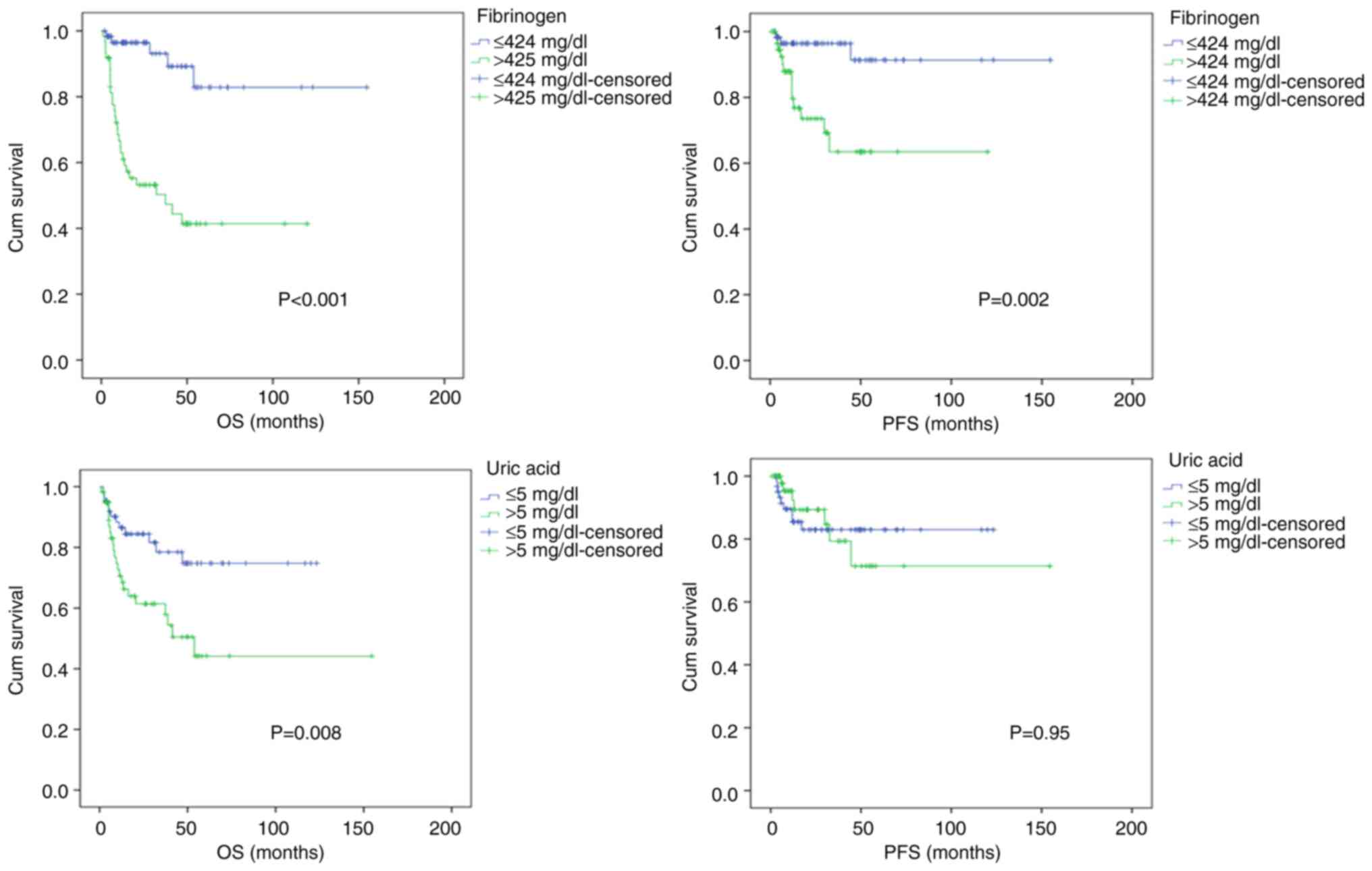|
1
|
Pizzi M, Boi M, Bertoni F and Inghirami G:
Emerging therapies provide new opportunities to reshape the
multifaceted interactions between the immune system and lymphoma
cells. Leukemia. 30:1805–1815. 2016.PubMed/NCBI View Article : Google Scholar
|
|
2
|
Roh JS and Sohn DH: Damage-associated
molecular patterns in inflammatory diseases. Immune Netw.
18(e27)2018.PubMed/NCBI View Article : Google Scholar
|
|
3
|
Chen GY and Nuñez G: Sterile inflammation:
Sensing and reacting to damage. Nat Rev Immunol. 10:826–837.
2010.PubMed/NCBI View
Article : Google Scholar
|
|
4
|
Vénéreau E, Ceriotti C and Bianchi ME:
DAMPs from cell death to new life. Front Immunol.
6(422)2015.PubMed/NCBI View Article : Google Scholar
|
|
5
|
Land WG: The role of damage-associated
molecular patterns (DAMPs) in human diseases: Part II: DAMPs as
diagnostics, prognostics and therapeutics in clinical medicine.
Sultan Qaboos Univ Med J. 15:e157–e170. 2015.PubMed/NCBI
|
|
6
|
Braga TT, Forni MF, Correa-Costa M, Ramos
RN, Barbuto JA, Branco P, Castoldi A, Hiyane MI, Davanso MR, Latz
E, et al: Soluble uric acid activates the NLRP3 inflammasome. Sci
Rep. 7(39884)2017.PubMed/NCBI View Article : Google Scholar
|
|
7
|
Grivennikov SI, Greten FR and Karin M:
Immunity, inflammation, and cancer. Cell. 140:883–899.
2010.PubMed/NCBI View Article : Google Scholar
|
|
8
|
Haybaeck J, Zeller N, Wolf MJ, Weber A,
Wagner U, Kurrer MO, Bremer J, Iezzi G, Graf R, Clavien PA, et al:
A lymphotoxin-driven pathway to hepatocellular carcinoma. Cancer
Cell. 16:295–308. 2009.PubMed/NCBI View Article : Google Scholar
|
|
9
|
Hernandez C, Huebener P and Schwabe RF:
Damage-associated molecular patterns in cancer: A double-edged
sword. Oncogene. 35:5931–5941. 2016.PubMed/NCBI View Article : Google Scholar
|
|
10
|
Matzinger P: Tolerance, danger, and the
extended family. Annu Rev Immunol. 12:991–1045. 1994.PubMed/NCBI View Article : Google Scholar
|
|
11
|
Schaefer L: Complexity of danger: The
diverse nature of damage-associated molecular patterns. J Biol
Chem. 289:35237–35245. 2014.PubMed/NCBI View Article : Google Scholar
|
|
12
|
Zhang X and Mosser DM: Macrophage
activation by endogenous danger signals. J Pathol. 214:161–178.
2008.PubMed/NCBI View Article : Google Scholar
|
|
13
|
Smiley ST, King JA and Hancock WW:
Fibrinogen stimulates macrophage chemokine secretion through
toll-like receptor 4. J Immunol. 167:2887–2894. 2001.PubMed/NCBI View Article : Google Scholar
|
|
14
|
Ye RD and Sun L: Emerging functions of
serum amyloid A in inflammation. J Leukoc Biol. 98:923–929.
2015.PubMed/NCBI View Article : Google Scholar
|
|
15
|
Lawrence SO and Simpson-Haidaris PJ:
Regulated de novo biosynthesis of fibrinogen in extrahepatic
epithelial cells in response to inflammation. Thromb Haemost.
92:234–243. 2004.PubMed/NCBI View Article : Google Scholar
|
|
16
|
Polterauer S, Grimm C, Seebacher V, Concin
N, Marth C, Tomovski C, Husslein H, Leipold H, Hefler-Frischmuth K,
Tempfer C, et al: Plasma fibrinogen levels and prognosis in
patients with ovarian cancer: A multicenter study. Oncologist.
14:979–985. 2009.PubMed/NCBI View Article : Google Scholar
|
|
17
|
Xu Q, Yan Y, Gu S, Mao K, Zhang J, Huang
P, Zhou Z, Chen Z, Zheng S, Liang J, et al: A novel
inflammation-based prognostic score: The fibrinogen/albumin ratio
predicts prognoses of patients after curative resection for
hepatocellular carcinoma. J Immunol Res.
2018(4925498)2018.PubMed/NCBI View Article : Google Scholar
|
|
18
|
Shehata AMF, Aldesoky AI and Gohar SF:
Plasma fibrinogen level as possible prognostic biomarker in diffuse
large B-cell lymphoma. Hematology. 24:103–107. 2019.PubMed/NCBI View Article : Google Scholar
|
|
19
|
Wang JW, Li KC, Shi Z and Tang X: Clinical
significance of plasma fibrinogen level in patients with
non-Hodgkin's lymphoma. Tumor. 34:370–373. 2014.
|
|
20
|
Troppan KT, Melchardt T, Wenzl K, Schlick
K, Deutsch A, Bullock MD, Reitz D, Beham-Schmid C, Weiss L,
Neureiter D, et al: The clinical significance of fibrinogen plasma
levels in patients with diffuse large B cell lymphoma. J Clin
Pathol. 69:326–330. 2016.PubMed/NCBI View Article : Google Scholar
|
|
21
|
Stotz M, Szkandera J, Seidel J, Stojakovic
T, Samonigg H, Reitz D, Gary T, Kornprat P, Schaberl-Moser R,
Hoefler G, et al: Evaluation of uric acid as a prognostic
blood-based marker in a large cohort of pancreatic cancer patients.
PLoS One. 9(e104730)2014.PubMed/NCBI View Article : Google Scholar
|
|
22
|
Yan S, Zhang P, Xu W, Liu Y, Wang B, Jiang
T, Hua C, Wang X, Xu D and Sun B: Serum uric acid increases risk of
cancer incidence and mortality: A systematic review and
meta-analysis. Mediators Inflamm. 2015(764250)2015.PubMed/NCBI View Article : Google Scholar
|
|
23
|
Chen YF, Li Q, Chen DT, Pan JH, Chen YH,
Wen ZS and Zeng WA: Prognostic value of pre-operative serum uric
acid levels in esophageal squamous cell carcinoma patients who
undergo R0 esophagectomy. Cancer Biomark. 17:89–96. 2016.PubMed/NCBI View Article : Google Scholar
|
|
24
|
Prochazka KT, Melchardt T, Posch F,
Schlick K, Deutsch A, Beham-Schmid C, Weiss L, Gary T, Neureiter D,
Klieser E, et al: NCCN-IPI score-independent prognostic potential
of pretreatment uric acid levels for clinical outcome of diffuse
large B-cell lymphoma patients. Br J Cancer. 115:1264–1272.
2016.PubMed/NCBI View Article : Google Scholar
|
|
25
|
Çelik S, Kaynar L, Güven ZT, Atasever
Duran K, Kontaş O, Keklik M and Ünal A: The effect of
danger-associated molecular patterns on survival in acute graft
versus host disease. Bone Marrow Transplant. 59:189–195.
2024.PubMed/NCBI View Article : Google Scholar
|










